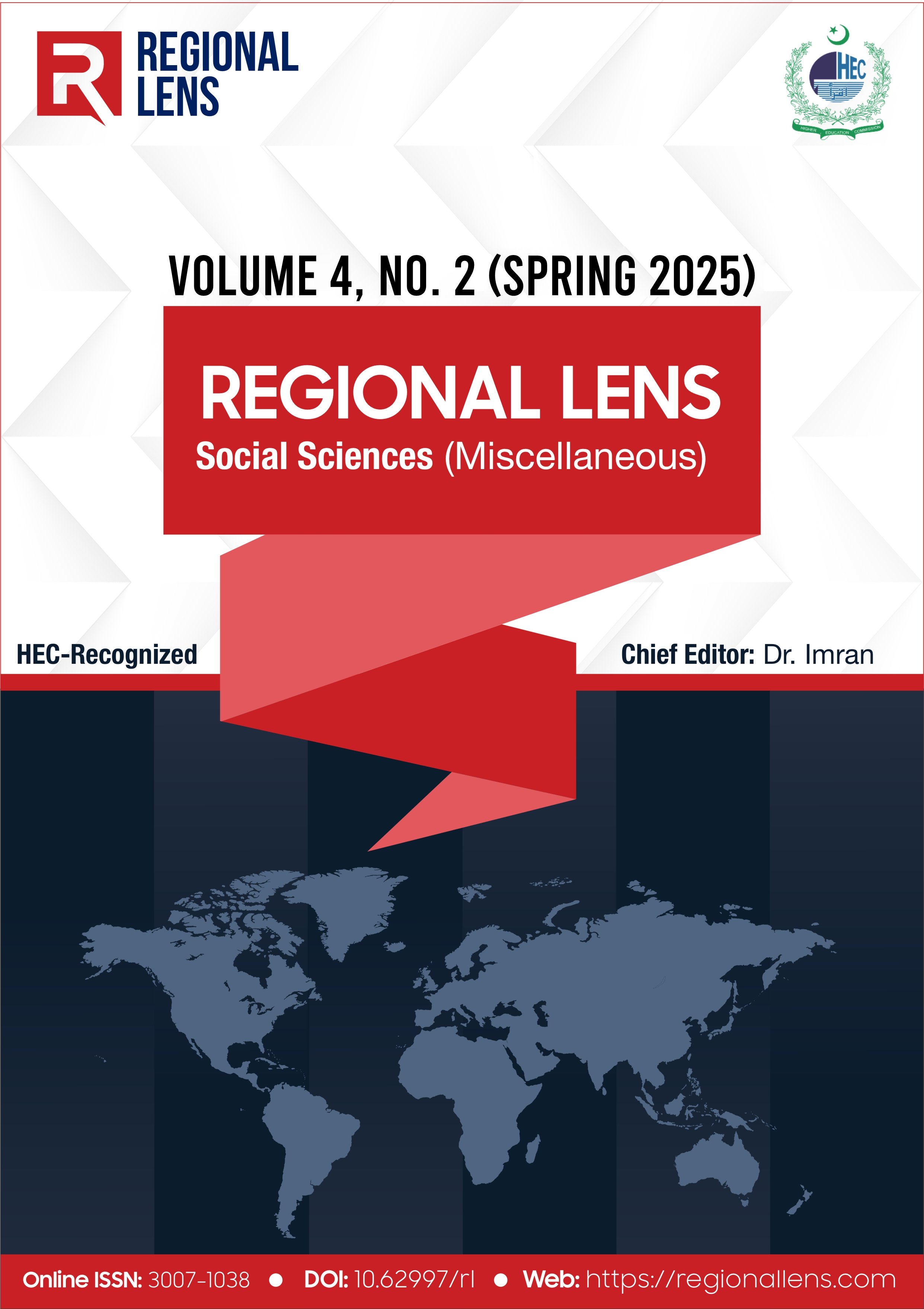Lived Experiences of Women with Major Depressive Disorder
DOI:
https://doi.org/10.62997/rl.2025.42064Keywords:
Depression, Cultural Influence, Depressive Symptoms, Women, Mental Health, Asian CultureAbstract
Culture contributes and influences the identity of people in a way that shapes their identity, beliefs and personality to feel socially integrated with people. Mental health disorders specifically expression of depressive symptoms among women in south Asian culture is misinterpreted and misjudged. To explore how Pakistani women experience and express their depressive symptoms, current study employs Interpretative Phenomenological Analysis (IPA). Semi-structured interviews with 20 women having a diagnosis of depression revealed that cultural stigma enhances emotional repression, economic dependency restricts access to mental health care, and fixed religious beliefs create a contradictory coping strategy. The findings demonstrate that although women with depressive symptoms have spiritual aspect, social support, and internal coping mechanisms to manage resilience, gendered pressures in family dynamics but also cause emotional alienation. These results provide clinical insight into the phenomena of mental health with cultural identity and emphasize the need for faith-integrated therapy, community-based psycho-education, and reasonably priced treatment. The study highlights the urgency of normalizing emotional expression, implementing gender-sensitive treatment techniques, and addressing systemic barriers in mental health through culturally relevant interventions.
References
Albert, P. R. (2015). Why is depression more prevalent in women? Journal of Psychiatry & Neuroscience, 40(4), 219–221. https://doi.org/10.1503/jpn.150205
American Psychiatric Association. (2013). Diagnostic and statistical manual of mental disorders (5th ed.).
Baldwin, J. R., Faulkner, S. L., Hecht, M. L., & Lindsley, S. L. (1999). Redefining culture: Perspectives across the disciplines. Routledge.
Bourdieu, P. (1984) Distinction: A Social Critique of the Judgment of Taste. Routledge & Kegan Paul, London.
Bowlby, J. (1988). D uring the first third of this century there were two great proponents of developmental psychiatry–Adolf Meyer and Sigmund Freud. Both believed that. The American journal of psychiatry, 145, 1-10
Chaudhry, H. R., Arshad, N., Javed, F., & Asif, A. (2010). Frequency of psychological and somatic symptoms in patients with major depressive disorder. Asian Journal of Psychiatry, 3(3), 152–154. https://doi.org/10.1016/j.ajp.2010.06.001
Choudhry, F. R., & Bokharey, I. Z. (2013). Perception of mental health in Pakistani nomads: An interpretative phenomenological analysis. International Journal of Qualitative Studies on Health and Well-being, 8(1), 22469. https://doi.org/10.3402/qhw.v8i0.22469
Ciftci, A., Jones, N., & Corrigan, P. W. (2013). Mental health stigma in the Muslim community. Journal of Muslim Mental Health, 7(1). https://doi.org/10.3998/jmmh.10381607.0007.102
Corrigan, P. W., & Rao, D. (2012). On the self-stigma of mental illness: Stages, disclosure, and strategies for change. The Canadian Journal of Psychiatry, 57(8), 464-469. https://doi.org/10.1177/070674371205700804
Cuijpers, P., Noma, H., Karyotaki, E., Cipriani, A., & Furukawa, T. A. (2019). Effectiveness and acceptability of cognitive behavior therapy delivery formats in adults with depression: a network meta-analysis. JAMA psychiatry, 76(7), 700-707. https://doi.org/10.1001/jamapsychiatry.2019.0268
Engel, G. L. (1977). The need for a new medical model: a challenge for biomedicine. Science (New York, N.Y.), 196(4286), 129–136. https://doi.org/10.1126/science.847460
Farhat-Holzman, L. (2012). Modernization or westernization: The Muslim world vs. the rest. Comparative Civilizations Review, 67(67), 7. https://scholarsarchive.byu.edu/ccr/vol67/iss67/
Gadit, A., Vahidy, A., & Shafique, F. (1998). Mental Health Morbidity: An experience in a community psychiatric clinic. J Coll Phys Surg Pk, 8(6), 262-4.
Garcia-Toro, M., & Aguirre, I. (2007). Biopsychosocial model in depression revisited. Medical hypotheses, 68(3), 683-691. https://doi.org/10.1016/j.mehy.2006.02.049
Gaw, A. (1993). Culture, Ethnicity, and Mental Illness. American Psychiatric Press.
Gilligan, C. (1982). In a different voice: Psychological theory and women's development. Harvard University Press.
Goffman, E. (1963). Stigma. Notes on the Management of Spoiled Identity. London: Penguin Books.
Gopalkrishnan, N. (2018). Cultural diversity and mental health: Considerations for policy and practice. Frontiers in Public Health, 6, 179. https://doi.org/10.3389/fpubh.2018.00179
Gross, J. J., & John, O. P. (2003). Individual differences in two emotion regulation processes: implications for affect, relationships, and well-being. Journal of Personality and Social Psychology, 85(2), 348–362. https://doi.org/10.1037/0022-3514.85.2.348
Hofstede, G. (2001). Culture’s Consequences: Comparing Values, Behaviors, Institutions and Organizations across Nations. SAGE, Thousand Oaks, London, New Delhi.
Javed, A., Lee, C., Zakaria, H., Buenaventura, R. D., Cetkovich-Bakmas, M., Duailibi, K., … Azeem, M. W. (2021). Reducing the stigma of mental health disorders with a focus on low- and middle-income countries. Asian Journal of Psychiatry, 58, 102601. https://doi.org/10.1016/j.ajp.2021.102601
Karasz, A., Dempsey, K., & Fallek, R. (2007). Cultural differences in the experience of everyday symptoms: A comparative study of South Asian and European American women. Culture, Medicine and Psychiatry, 31(4), 473–497. https://doi.org/10.1007/s11013-007-9066-y
Koenig, H. G. (2012). Religion, spirituality, and health: The research and clinical implications. ISRN Psychiatry, 2012, 278730. https://doi.org/10.5402/2012/278730
Kohrt, B. A., Asher, L., Bhardwaj, A., Fazel, M., Jordans, M. J. D., Mutamba, B. B., Nadkarni, A., Pedersen, G. A., Singla, D. R., & Patel, V. (2018). The role of communities in mental health care in low- and middle-income countries: A meta-review of components and competencies. International Journal of Environmental Research and Public Health, 15(6), 1279. https://doi.org/10.3390/ijerph15061279
Levine, R. E., & Gaw, A. C. (1995). Culture-bound syndromes. The Psychiatric Clinics of North America, 18(3), 523–536. https://doi.org/10.1016/s0193-953x(18)30038-8
Luna, Y. M., & Montoya, T. M. (2019). “I need this chance to … help my family”: A qualitative analysis of the aspirations of DACA applicants. Social Sciences (Basel, Switzerland), 8(9), 265. https://doi.org/10.3390/socsci8090265
Maddock, A., Blair, C., Ean, N., & Best, P. (2021). Psychological and social interventions for mental health issues and disorders in Southeast Asia: a systematic review. International journal of mental health systems, 15(1), 56. https://doi.org/10.1186/s13033-021-00482-y
Mikulincer, M., & Shaver, P. (2016). Attachment in Adulthood. Guilford Press.
Mirza, I., Mujtaba, M., Chaudhry, H., & Jenkins, R. (2006). Primary mental health care in rural Punjab, Pakistan: providers, and user perspectives of the effectiveness of treatments. Social Science & Medicine (1982), 63(3), 593–597. https://doi.org/10.1016/j.socscimed.2006.01.028
Nolen-Hoeksema, S. (2012). Emotion regulation and psychopathology: the role of gender. Annual Review of Clinical Psychology, 8(1), 161–187. https://doi.org/10.1146/annurev-clinpsy-032511-143109
Noreen, S., Khan, I. A., Anjum, F., & Ashraf, E. (2021). Modernity and changing cultural patterns in Pakistan. Humanities & Social Sciences Reviews, 9(3), 344–349. https://doi.org/10.18510/hssr.2021.9335
Pargament, K. I. (1997). The psychology of religion and coping: Theory, research, practice. Guilford Press.
Pearce, M., Haynes, K., Rivera, N. R., & Koenig, H. G. (2018). Spiritually integrated cognitive processing therapy: A new treatment for post-traumatic stress disorder that targets moral injury. Global advances in health and medicine, 7, 2164956118759939. https://doi.org/10.1177/2164956118759939
Rahman, A., Malik, A., Sikander, S., Roberts, C., & Creed, F. (2008). Cognitive behaviour therapy-based intervention by community health workers for mothers with depression and their infants in rural Pakistan: A cluster-randomised controlled trial. The Lancet, 372(9642), 902–909. https://doi.org/10.1016/S0140-6736(08)61400-2
Roy-Byrne, P. P., Joesch, J. M., Wang, P. S., & Kessler, R. C. (2009). Low socioeconomic status and mental health care use among respondents with anxiety and depression in the NCS-R. Psychiatric Services, 60(9), 1190-1197. https://doi.org/10.1176/ps.2009.60.9.1190
Shafiq, S. (2020). Perceptions of Pakistani community towards their mental health problems: A systematic review. General Psychiatry, 33(1), e100001. https://doi.org/10.2478/gp-2020-0001
Sik, D. (2019). From mental disorders to social suffering: Making sense of depression for critical theories. European Journal of Social Theory, 22(4), 477-496. https://doi.org/10.1177/1368431018760947
Taj, R. (2016). Mental health in Pakistan. In D. Bhugra, S. Tse, R. Ng, & N. Takei (Eds.), Routledge handbook of psychiatry in Asia (pp. 101–114). Routledge.
Willis, R., Zaidi, A., Balouch, S., & Farina, N. (2020). Experiences of people with dementia in Pakistan: Help-seeking, understanding, stigma, and religion. The Gerontologist, 60(1), 145-154. https://doi.org/10.1093/geront/gny143
Yu, L. C., Wang, M. Q. I., Kaltreider, L., & Chien, Y.-Y. (1993). The impact of family migration and family life cycle on the employment status of married, college-educated women. Work and Occupations, 20(2), 233–246. https://doi.org/10.1177/0730888493020002005




